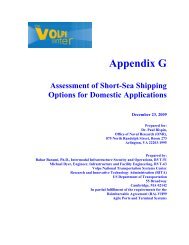Container-on-Barge Pre-Feasibility Study Final Report - Towmasters ...
Container-on-Barge Pre-Feasibility Study Final Report - Towmasters ...
Container-on-Barge Pre-Feasibility Study Final Report - Towmasters ...
You also want an ePaper? Increase the reach of your titles
YUMPU automatically turns print PDFs into web optimized ePapers that Google loves.
Initial Assumpti<strong>on</strong>s:<br />
1. Freight traffic in the U.S. is expected to double in the next twenty years, placing<br />
excessive demands <strong>on</strong> existing road and rail infrastructure.<br />
2. COB is a highly successful alternative for road and rail freight movements in Europe,<br />
the Pacific Northwest, and other places in the world.<br />
3. COB is technically feasible, ec<strong>on</strong>omically attractive and envir<strong>on</strong>mentally<br />
advantageous for the Ohio-Mississippi River System.<br />
4. COB could utilize existing jumbo barges, holding 72 TEU c<strong>on</strong>tainers (stacked 3-<br />
high), and existing river terminals that have 25 t<strong>on</strong> plus cranes and storage capacity<br />
for 180 c<strong>on</strong>tainers in order to initiate service.<br />
Shipper Identified Obstacles to COB Traffic <strong>on</strong> the Inland Waterways:<br />
1. The Chicken and Egg Syndrome. <str<strong>on</strong>g>C<strong>on</strong>tainer</str<strong>on</strong>g> shippers are reluctant to commit cargo for<br />
a service that the barge lines do not offer <strong>on</strong> a predictable, regular and reliable basis, with<br />
point-to-point rates. <strong>Barge</strong> lines are reluctant to commit barges to a service without the<br />
guarantee of sufficient cargo.<br />
2. Historical Perspectives. <strong>Pre</strong>vious failed COB attempts have c<strong>on</strong>vinced some skeptics<br />
that it is impossible to do COB <strong>on</strong> the Ohio-Mississippi system, but the failures may have<br />
been due to specific business problems. The previous attempts <strong>on</strong> the lower Mississippi<br />
were hampered by cut-rate rail competiti<strong>on</strong> in an extremely competitive north-south rail<br />
network that parallels the Mississippi River; the lack of deep pockets to withstand such<br />
competiti<strong>on</strong>; the lack of experience in dealing with unique c<strong>on</strong>tainer handling<br />
requirements; and, for both the Mississippi and Ohio systems, the dependence <strong>on</strong> single<br />
shippers who may change their supply chain logistics requirements for other business<br />
reas<strong>on</strong>s.<br />
3. Complex Research and Operati<strong>on</strong>al Organizati<strong>on</strong>. Efficiencies of scale indicate 72<br />
TEU c<strong>on</strong>tainers could be organized and staged together at <strong>on</strong>e time for <strong>on</strong>e destinati<strong>on</strong> to<br />
minimize time-c<strong>on</strong>suming, multiple stops and possible re-stowage of cargo. Identifying<br />
the shippers and organizing the COB service is a complex problem and needs to be d<strong>on</strong>e<br />
at both ends of the system (Pittsburgh and Brownsville) as well as other ports that wish to<br />
participate. Identifying the potential customers in the U.S. for inland ports will be more<br />
difficult than for ocean ports since the utility of PIER data is less applicable. Identifying<br />
potential customers in the Mexican market, where there is less familiarity with barge<br />
transportati<strong>on</strong>, will require extensive pers<strong>on</strong>al c<strong>on</strong>tact.
















